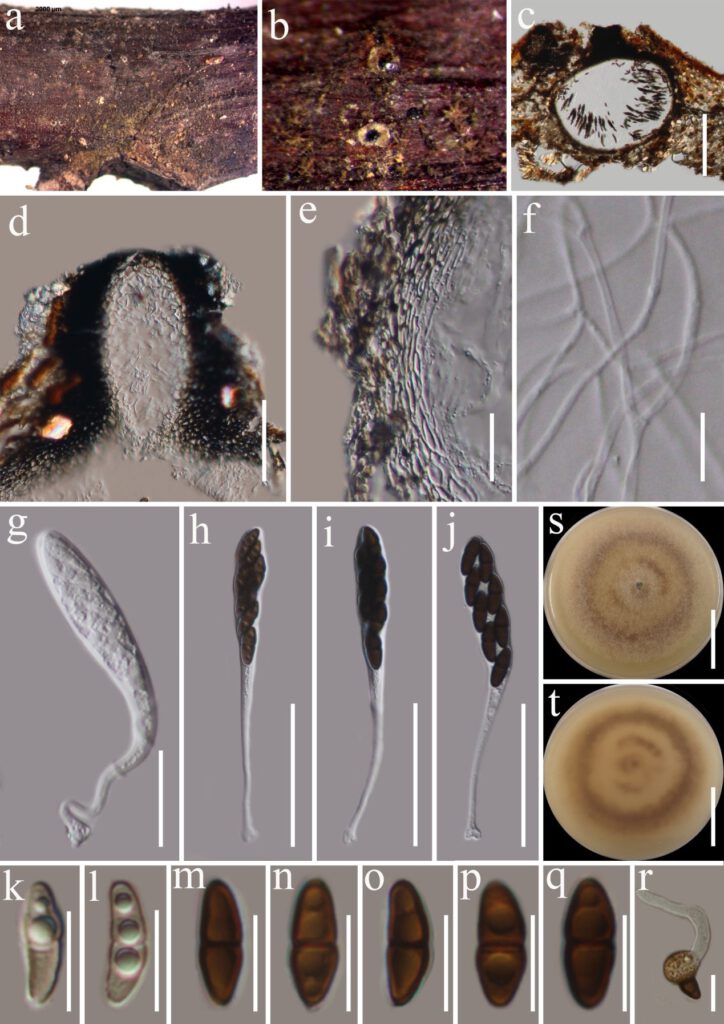Montagnula donacina Montagnula donacina (Niessl) Wanas., E.B.G. Jones & K.D. Hyde Fungal Biology 120(11): 1365 (2016) Fig. 8
≡ Microthelia donacina Niessl, in Thümen, Inst. Coimbra 28: no. 536 (1879)
≡ Didymosphaeria donacina (Niessl) Sacc., Syll. fung. (Abellini) 1: 715 (1882)
≡ Didymosphaerella donacina (Niessl) Cooke, Grevillea 18(no. 86): 29 (1889)
≡ Munkovalsaria donacina (Niessl) Aptroot, Nova Hedwigia 60(3-4): 346 (1995)
MycoBank number: MB 626421; Index Fungorum number: IF 626421; Facesoffungi number: FoF 04638;
Saprobic on decaying wood. Sexual morph: Ascomata 320–400 µm high×350–440 µm diam. (x̅ = 350 × 400 µm, n = 5), immersed to erumpent, solitary or scattered, coriaceous, black, with central ostiolate. Ostiole short papillate, 150–190 × 70–90 µm (x̅ = 170 × 80 µm, n = 5), protruding from substratum. Peridium 15–25 µm wide, comprising 4–6 layers of thin-walled, pale brown to brown cells of textura angularis. Hamathecium comprising 1–2 µm wide, hyaline, cylindrical to fliform, septate, branching pseudoparaphyses. Asci 70–100 × 10–11 µm (x̅ = 87 × 10.7 µm, n = 15), bitunicate, fissitunicate, 8-spored, elongate-clavate, slightly curved, with a long pedicel (30–50 µm long; x̅ = 40 μm, n = 10) pedicel. Ascospores 14–16 × 4.5–6 µm (x̅ = 14.5 × 5 µm, n = 30), overlapping uni to bi-seriate, hyaline or yellowish when immature and becoming brown to dark brown when mature, 2-celled, fusiform with rounded ends, 1-septate, constricted at the septum, slightly pointed upper cell and rounded lower cell, straight to slightly curved, smooth-walled, guttulate, without sheath or appendages. Asexual morph: Undetermined.
Culture characteristics ‒ Colonies on PDA, reaching 90 mm diam. at 14 days at room temperature (25–30 ℃), superficial, circular, surface rough, with sparse mycelia, velvety, flat, from below and from below, zonate, white at the margin and center, light brown between margin and center.
Known distribution ‒ Hosts – Acacia reficiens, Acacia sp, Adhatoda vasica, Ailanthus altissima, Annona squamosa, Arundo donax, Bambusoideae sp., Cajanus cajan, Calamus australis, Careya arborea, Citrus aurantiifolia, Clerodendrum infortunatum, Clerodendrum multiflorum, Coffea arabica, Coffea robusta, Dioscorea dumetorum, Duranta repens, Ficus glomerata, Funtumia africana, Hibiscus sp., Lantana camara, Lpomoea carnea, Mallotus philippinensis, Morus alba, Nephelium litchi, Nerium odorum, Phyllostachys bambusoides, Pistacia indica, Platanus sp., Premna cumingiana, Pseudosasa japonica, Saccharum officinarum, Strophanthus eminii, Tectona grandis, Terminalia tomentosa, Trachycarpus fortunei, Wikstroemia sp., Zea mays (Farr & Rossman 2021). Distribution – Australia, Brazil, Central African Republic, China, Colombia, France, Georgia, Hawaii, India, Japan, Louisiana, Myanmar, Namibia, Nigeria, Papua New Guinea, Paraguay, Philippines, Portugal, Sierra Leone, Tanzania (Farr & Rossman 2022).
Material examined ‒ China, Yunnan Province, Xishuangbanna Dai Autonomous Prefecture, Jinghong, Xishuangbanna Tropical Botanical Garden (21°55.19’N, 101°15.24’E), on dead woody twigs of Ehretia acuminata (Boraginaceae), 4 March 2020, G. C. Ren, JH27 (KUN-HKAS 122782), living culture, KUMCC 21-0579; Thailand, Chiang Rai Province, Mae Yao District, on dead woody twigs of Betula sp., 23 September 2019, G.C. Ren, MY22 (KUN-HKAS 122780), living culture KUMCC 21-0631; Thailand, Tak Province, Near Mae Jun river and police’s school Ban Mea Junta, on dead woody twigs of Betula sp., 21 August 2019, G.C. Ren, T404 (KUN-HKAS 122778), living culture KUMCC 21-0653; Thailand, Chiang Mai Province, Yang Piang Omkoi, on dead woody twigs of Betula sp., 25 August 2019, G.C. Ren, YP07 (KUN-HKAS 122779), living culture KUMCC 21-0681, PK10 (KUN-HKAS 122781), living culture KUMCC 21-0647.
Notes ‒ Montagnula donacina, which was previously known as Munkovalsaria donacina, was introduced by Wanasinghe et al. (2016) based on phylogenetic analyses of combined LSU, SSU, and ITS. Generally, Montagnula donacina is characterized by immersed to erumpent, single or gregarious ascomata with one ostiole, bitunicate, clavate or cylindrical asci with a pedicel and a ocular chamber, ellipsoid, unicellular, 1-septate ascospores strongly constricted at the septum with the upper cell wider and the lower cell rounded (Aptroot 1955; Pitt et al. 2014). The characters of our new strains (KUMCC KUMCC 21-0653, KUMCC 21-0681, KUMCC 21-0579, KUMCC 21-0631, KUMCC 21-0647) are similar to Montagnula donacina (Pitt et al. 2014). The multi-gene phylogenetic analysis based on combined SSU, LSU, ITS, and tef1–α sequence data showed that our collection (KUMCC KUMCC 21-0653, KUMCC 21-0681, KUMCC 21-0579, KUMCC 21-0631, KUMCC 21-0647) is monophyletic with Montagnula thailandica (MFLUCC 17-1508), Montagnula puerensis (KUMCC 20-0225, KUMCC 20-0331), Montagnula donacina (HFG07004, HVVV01), Montagnula chromolaenicola (MFLUCC 17-1469), Montagnula saikhuensis (MFLUCC 16-0315) and Montagnula graminicola (MFLUCC 13-0352) (Fig. 1). Based on morphological characteristics and phylogenetic analysis, we report our isolations as new host records of Montagnula donacina from decaying wood of Ehretia acuminate, Betula sp. in Thailand, detailed information on Montagnula are under discussion.

Figure 8 ‒ Montagnula donacina (KUN-HKAS 122782). a, b Appearance of ascomata on host substrate. c Section of ascoma. d Ostiolar neck. e Peridium. f Hamathecium. g‒j Asci. k‒q Ascospores. r Germinated ascospore. s, t Culture characters on PDA (s = from above, t = from below). Scale bars: c = 200 μm, d, h‒j = 50 μm, e, g = 20 μm. f, k‒r = 10 μm, s, t = 30 mm.
